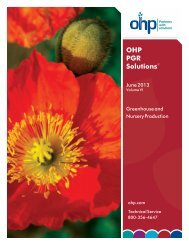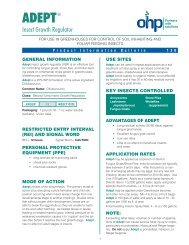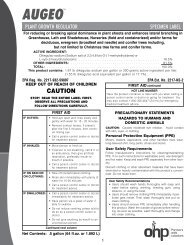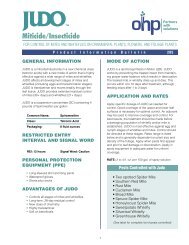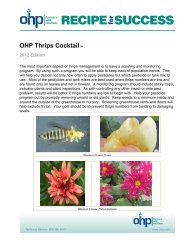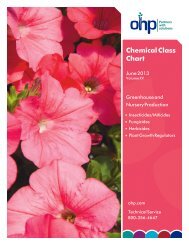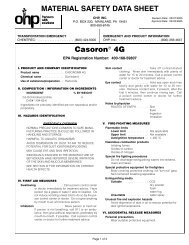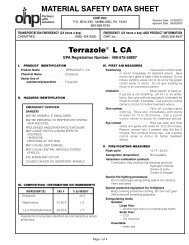Chemical Class Chart - OHP, Inc.
Chemical Class Chart - OHP, Inc.
Chemical Class Chart - OHP, Inc.
You also want an ePaper? Increase the reach of your titles
YUMPU automatically turns print PDFs into web optimized ePapers that Google loves.
<strong>Chemical</strong> <strong>Class</strong> <strong>Chart</strong><br />
Volume XI I<br />
Greenhouse and Nursery Production<br />
Insecticides/Miticides<br />
Fungicides<br />
Herbicides<br />
Plant Growth Regulators<br />
Technical Service 800-356-4647 ohp.com
REFERENCE GUIDE for ORNAMENTAL PRODUCTION<br />
INSECTICIDES / MITICIDES<br />
RESISTANCE MANAGEMENT<br />
When applying insecticides / miticides, always focus on resistance management. Do not rely on one product or tank mix or<br />
the same mode of action.<br />
When labels permit, make 2 or 3 applications of a product or tank mix in sequence, then rotate to products with different<br />
modes of action. Try to avoid applying the same mode of action to more than one generation of the pest.<br />
NOTE: THIS IS ONE OF THE MAIN REASONS WHY IT IS VITALLY IMPORTANT TO PROPERLY DETECT THE PROBLEM<br />
PEST AND KEEP GOOD SPRAY RECORDS.<br />
Using insecticides / miticides correctly also includes proper timing, understanding the pest life cycle, and the stage that<br />
each product controls. The appropriate and labeled (legal) method of application is also a very important factor to consider.<br />
Low volume (L.V.) applications (smoke generator, thermal fog, cold fog, aerosol, and electrostatic) are commonly used in<br />
greenhouses. Low volume sprays generally are more effective against adults than immature stages. Use high volume<br />
sprays, directed under the leaves for best results against eggs, nymphs and pupae.<br />
Always read the label and check with your state or county extension specialists for further information regarding resistance<br />
management.<br />
**Use Site(s) KEY: GH = Greenhouse; N = Nursery<br />
Insecticides / Miticides<br />
(by Mode of Action Group and <strong>Class</strong>)<br />
MOA<br />
Use<br />
Group* <strong>Class</strong> Common Name Trade Name REI Site(s)** Company<br />
1A Carbamates Carbaryl Sevin ® 12 N Bayer Environmental<br />
Science<br />
Methiocarb Mesurol ® 24 GH/N Gowan Company<br />
1B Organophosphates Acephate Orthene ® TT&O 24 GH/N Amvac <strong>Chemical</strong><br />
Corp.<br />
Orthene ® TR 24 GH BASF<br />
Chlorpyrifos DuraGuard ® ME 24 GH/N BASF<br />
Dursban ® 50 WP 24 N Dow AgroSciences<br />
LLC<br />
Dichlorvos Fulex DDVP Fumigator * GH Fuller System, <strong>Inc</strong><br />
Dimethoate Dimethoate 267 48 N Arysta LifeScience<br />
AllPro ® Cygon 2E 48 N Value Garden Supply<br />
Naled Dibrom ® * GH Amvac <strong>Chemical</strong><br />
Corp.<br />
Malathion Gowan Malathion 8F 12 N Gowan Company<br />
Methidathion Supracide ® 3 days N Gowan Company<br />
Oxydemeton-methyl MSR ® Spray 10 days N Gowan Company<br />
Concentrate<br />
Phosmet Imidan ® 70W 24 N Gowan Company<br />
2 Cyclodiene organochlorines Endosulfan Thionex ® 24 N Makhteshim Agan,<br />
<strong>Inc</strong>.<br />
* Depends on greenhouse ventilation<br />
1<br />
© 2010. <strong>OHP</strong>, <strong>Inc</strong>.
Insecticides / Miticides <br />
(by Mode of Action Group and <strong>Class</strong>)<br />
continued<br />
MOA<br />
Use<br />
Group* <strong>Class</strong> Common Name Trade Name REI Site(s)** Company<br />
3 Pyrethroids Bifenthrin Talstar ® 12 GH/N** FMC Corp. .<br />
OnyxPro 12 N FMC Corp.<br />
Attain ® TR 12 GH BASF<br />
Cyfluthrin Decathlon ® 12 GH/N <strong>OHP</strong>, <strong>Inc</strong>.<br />
Fenpropathrin Tame ® 24 GH/N Valent USA Corp.<br />
Fluvalinate Mavrik ® 12 GH Wellmark International<br />
Lambda-Cyhalothrin Scimitar ® GC 24 GH/N Syngenta<br />
Permethrin Astro ® 12 GH FMC Corp.<br />
Permethrin 3.2 EC 12 GH/N*** Helena <strong>Chemical</strong> Co.<br />
Ambush ® 12 GH/N*** Amvac<br />
<strong>Chemical</strong> Corp.<br />
*** Greenhouse roses only<br />
Fulex Permethrin Fumigator * GH Fuller System, <strong>Inc</strong>.<br />
Botanicals Pyrethrins Pyrethrum ® TR 12 GH BASF<br />
Pyreth-It ® 12 GH/N BASF<br />
4A Neonicotinoids Acetamiprid TriStar ® 12 GH/N Cleary <strong>Chemical</strong><br />
Corp.<br />
Dinotefuran Safari ® 12 GH/N Valent USA Corp.<br />
Imidacloprid Marathon ® 12 GH/N <strong>OHP</strong>, <strong>Inc</strong>.<br />
Thiamethoxam Flagship 12 GH/N Syngenta<br />
5 Spinosyns Spinosad Conserve ® 4 GH/N Dow AgroSciences<br />
LLC<br />
Entrust ® 4 GH/N Dow AgroSciences<br />
LLC<br />
6 Glycosides Abamectin Avid ® 12 GH/N Syngenta<br />
Milbemectin Ultiflora 12 N Gowan Company<br />
7A Juvenile hormone s-Kinoprene Enstar ® II 12 GH Wellmark International<br />
mimics<br />
7B Fenoxycarb Preclude ® TR 4 GH BASF<br />
7C Pyridine insect growth Pyriproxyfen Distance ® 12 GH/N Valent USA Corp.<br />
regulators<br />
9 A Pyridine azomethines Pymetrozine Endeavor ® 12 GH/N Syngenta<br />
9B Pyridine carboxamides Flonicamid Aria 12 GH FMC Corp.<br />
* Depends on greenhouse ventilation<br />
© 2010. <strong>OHP</strong>, <strong>Inc</strong>.<br />
2<br />
** Greenhouse and/or nursery uses depend<br />
on the formulation. Check labels for uses.
Insecticides / Miticides <br />
(by Mode of Action Group and <strong>Class</strong>)<br />
continued<br />
MOA<br />
Use<br />
Group* <strong>Class</strong> Common Name Trade Name REI Site(s)** Company<br />
10A Tetrazines Clofentezine Ovation ® 12 GH/N Scotts Company<br />
Thiazolidinones Hexythiazox Hexygon ® DF 12 GH/N Gowan Company<br />
10 B 2, 4 - Diphenyloxzoline Etoxazole TetraSan ® 12 GH/N Valent USA Corp.<br />
Derivatives<br />
11 Biopesticides Bacillus thuringiensis DiPel ® 12 GH/N Valent USA Corp.<br />
Kurstaki<br />
Deliver ® 12 GH/N Certis USA, LLC.<br />
Bacillus thuringiensis Gnatrol ® 4 GH/N Valent USA Corp.<br />
Israelensis<br />
12 Organotins Fenbutatin-oxide ProMite 48 GH/N SePRO Corp.<br />
13 Pyrroles Chlorfenapyr Pylon ® 12 GH BASF<br />
15 Benzoyl Urea Insect Diflubenzuron Adept ® 12 GH <strong>OHP</strong>, <strong>Inc</strong>.<br />
Growth Regulators<br />
Dimilin ® 25W, SC 12 GH/N** <strong>OHP</strong>, <strong>Inc</strong>.<br />
Novaluron Pedestal 12 GH/N <strong>OHP</strong>, <strong>Inc</strong>.<br />
16 Buprofezin Talus ® 12 GH/N SePRO Corp.<br />
17 Triazine Insect Cyromazine Citation ® 12 GH/N Syngenta<br />
Growth Regulators<br />
18 Diacylhydrazine Tebufenozide Confirm ® 4 N Dow AgroSciences<br />
LLC<br />
20A Trifluoromethyl Hydramethylnon Amdro ® Pro 12 N BASF<br />
Aminohydrazone<br />
20B Napthoquinone Derivatives Acequinocyl Shuttle O 12 GH/N <strong>OHP</strong>, <strong>Inc</strong>.<br />
21A Pyridazinones Pyridaben Sanmite ® 12 GH/N Gowan Company<br />
Phenoxypyrazoles Fenpyroximate Akari ® 12 GH SePRO Corp.<br />
23 Tetronic acids Spiromesifen Judo 12 GH/N <strong>OHP</strong>, <strong>Inc</strong>.<br />
Tetramic acids spirotetramat Kontos 24 GH/N <strong>OHP</strong>, <strong>Inc</strong>.<br />
Unknown Carbazates Bifenazate Floramite ® 12 GH/N <strong>OHP</strong>, <strong>Inc</strong>.<br />
Biopesticide Insect Azadirachtin Azatin ® XL 4 GH/N <strong>OHP</strong>, <strong>Inc</strong>.<br />
Growth Regulators<br />
Pyridalyl Overture ® 12 GH Valent USA Corp.<br />
* Depends on greenhouse ventilation ** Greenhouse and/or nursery uses depend on the<br />
formulation. Check labels for uses.<br />
© 2010. <strong>OHP</strong>, <strong>Inc</strong>.<br />
3
Insecticides / Miticides <br />
(by Mode of Action Group and <strong>Class</strong>)<br />
continued<br />
MOA<br />
Use<br />
Group* <strong>Class</strong> Common Name Trade Name REI Site(s)** Company<br />
M Biopesticides Beauveria bassiana Naturalis ® L 4 GH/N(V) <strong>OHP</strong>, <strong>Inc</strong>.<br />
© 2010. <strong>OHP</strong>, <strong>Inc</strong>.<br />
4<br />
BotaniGard ® 4 GH/N BioWorks, <strong>Inc</strong>.<br />
Mycotrol O ® 4 GH/N BioWorks, <strong>Inc</strong>.<br />
Paecilomyces fumorosoroseus PFR-97 4 GH/N Certis USA LLC<br />
Oils Clarified hydrophobic Triact ® 70 4 GH/N <strong>OHP</strong>, <strong>Inc</strong>.<br />
extract of neem oil<br />
Paraffinic oil Ultra-Pure Oil 4 GH/N BASF<br />
Petroleum Oil PureSpray Green ® 4 GH/N BASF<br />
Suffoil-X 4 GH/N BioWorks, <strong>Inc</strong>.<br />
Soaps Potassium salts of Insecticidal Soap 40% 12 GH/N Value Garden Supply<br />
fatty acids<br />
MOA Combination Products<br />
M-Pede ® 12 GH/N Dow AgroSciences<br />
LLC<br />
MOA<br />
Use<br />
Codes <strong>Class</strong>es Common Names Trade Name REI Site(s)** Company<br />
1+3 Organophosphate + Acephate + Tame/Orthene TR 24 GH Whitmire Micro-Gen<br />
Pyrethroid<br />
Fenpropathrin<br />
1+3 Organophosphate + Chlorpyrifos + DuraPlex ® TR 24 GH Whitmire Micro-Gen<br />
Pyrethroid<br />
Cyfluthrin<br />
3+4A Pyrethroid + Cyfluthrin + Discus ® N/G 12 GH/N <strong>OHP</strong>, <strong>Inc</strong>.<br />
Neonicotinoid<br />
Imidacloprid<br />
*Insecticides / Miticides Modes of Action<br />
1. Acetyl cholinesterase inhibitors. Inhibition of the enzyme acetylcholinesterase, interrupting the transmission of nerve impulses<br />
2. GABA-gated chloride channel antagonists: Interferes with GABA receptors of insect neurons, leading to repetitive nervous discharges<br />
3. Sodium channel modulators: Acts as an axonic poison by interfering with the sodium channels of both the peripheral and central nervous system stimulating<br />
repetitive nervous discharges, leading to paralysis.<br />
4. Acetylcholine receptor agonists/Antagonists: Binds to nicotinic acetylcholine receptor disrupting nerve transmission.<br />
5. Nicotine acetylcholine receptor agonists (not group 4)<br />
6. Chloride Channel Activators: Interferes with the GABA nerve receptor of insects.<br />
7. Juvenile hormone mimics (Insect growth regulator): Mimic juvenile hormones, which prevent molting from the larval to the adult stage.<br />
9. Compounds of unknown or non-specific mode of action (selective feeding blockers)<br />
10. Compounds of unknown or non-specific target site of action (mite growth inhibitors)<br />
11. Microbial disruptors of insect midgut membranes.<br />
12. Inhibition of oxidative phosphorylation at the site of dinitrophenol uncoupling (Disrupt ATP formation)<br />
13. Uncoupler of oxidative phosphorylation (disrupt H proton gradient formation).<br />
15. Inhibit chitin biosynthesis – type 0, Lepidopteran<br />
16. Inhibit chitin biosynthesis – type 1, Homopteran<br />
17. Molting disruptor, Dipteran<br />
18. Ecdysone agonists/molting disruptors<br />
20. Coupling site II electron transport inhibitors (Complex III)<br />
21. Site I electron transport inhibitor: ( METI acaricides/insecticides)<br />
23. Inhibitors of acetyl CoA carboxylase<br />
U Products with unknown or uncertain modes of action<br />
M Miscellaneous<br />
This list is from the U.S Environmental Protection Agency, in cooperation with the Insecticide Resistance Action Committee (IRAC). IRAC is a technical<br />
working group within the Global Crop Protection Federation (GCPF). More information on the Insecticide Resistance Action Committee and the Mode of<br />
Action <strong>Class</strong>ification is available from: www.irac-online.org.
REFERENCE GUIDE for ORNAMENTAL PRODUCTION FUNGICIDES<br />
As with other pesticides, fungicides must be used in a program to avoid or delay resistance. Do not rely on products with<br />
the same mode of action. Rotation of products with different modes of action, and using product combinations with different<br />
modes of action are parts of a resistance management strategy. Be especially careful when using products considered to<br />
be high risk for resistance development. This category includes many of our newer products. See the explanation of resistance<br />
risk at the end of the fungicide section.<br />
Most fungicides work more effectively to prevent disease from becoming established, rather than eradicating disease that is<br />
already present. Constant monitoring – and modification where possible – of environmental conditions and scouting crops<br />
for signs of disease symptoms are vital parts of effective fungicide use and resistance management.<br />
Always read the label and check with local authorities for further information regarding resistance management.<br />
**Use Site(s) Key: GH = Greenhouse; N = Nursery.<br />
Fungicides<br />
(by Mode of Action Group and <strong>Class</strong>)<br />
MOA Code*<br />
Use<br />
& Group <strong>Class</strong> Common Name Trade Name REI Site(s)** Company<br />
1 Thiophanates Thiophanate-methyl <strong>OHP</strong> 6672 12 GH/N <strong>OHP</strong>, <strong>Inc</strong>.<br />
Resistance risk High (See explanation of resistance risk following the mode of action listing)<br />
5<br />
3336 12 GH/N Cleary <strong>Chemical</strong><br />
Corp.<br />
AllBan ® 12 GH/N Scotts Company<br />
2 Dicarboximides Iprodione <strong>OHP</strong> Chipco ® 26019 N/G 12 GH/N <strong>OHP</strong>, <strong>Inc</strong>.<br />
Resistance risk Medium to High<br />
3 Imidazole Triflumizole Terraguard ® 12 GH/N <strong>OHP</strong>, <strong>Inc</strong>.<br />
Imazalil Fungaflor ® 24 GH BASF<br />
Pyrimidine Fenarimol Rubigan ® 12 N Gowan Company<br />
Triazole (includes conazole) Propiconazole Banner ® MAXX ® 12 N Syngenta<br />
Demethylation Inhibitors Triadimefon Strike ® 50 WDG 12 GH/N <strong>OHP</strong>, <strong>Inc</strong>.<br />
(DMI fungicides)<br />
Resistance risk Medium<br />
Myclobutanil Eagle ® 20 EW 24 GH/N Dow AgroSciences<br />
LLC<br />
4 Acylamine Metalaxyl-M (=Mefanoxam) Subdue ® MAXX ® 0 to 48 GH/N Syngenta<br />
Phenylamides (PA fungicides)<br />
Resistance risk Medium to High<br />
5 Piperadines Piperalin Pipron ® 12 GH SePRO Corp.<br />
Amines ("Morpholines")<br />
Resistance risk Low to Medium<br />
7 Phenyl-Benzamides Flutolanil ProStar ® 12 GH/N Bayer Environmental<br />
Science<br />
Carboxamides<br />
Resistance risk Medium<br />
© 2010. <strong>OHP</strong>, <strong>Inc</strong>.
Fungicides <br />
(by Mode of Action Group and <strong>Class</strong>)<br />
continued<br />
MOA Code*<br />
Use<br />
& Group <strong>Class</strong> Common Name Trade Name REI Site(s)** Company<br />
11 Strobilurins Trifloxystrobin Compass ® O 12 GH/N <strong>OHP</strong>, <strong>Inc</strong>.<br />
Fluoxastrobin Disarm O 12 GH/N <strong>OHP</strong>, <strong>Inc</strong>.<br />
Azoxystrobin ® Heritage ® 4 GH/N Syngenta<br />
Kresoxim-methyl ® Cygnus ® 12 GH/N BASF<br />
Pyraclostrobin Insignia ® 12 GH/N BASF<br />
Imidazolinones Fenamidone FenStop 12 GH <strong>OHP</strong>, <strong>Inc</strong>.<br />
Quinone outside Inhibitors (QoI fungicides)<br />
Resistance risk High<br />
12 Phenylpyrrole Fludioxonil Medallion ® 12 GH/N Syngenta<br />
(PP fungicides)<br />
Resistance risk Low to Medium<br />
14 Aromatic Hydrocarbon PCNB Terraclor ® 12 GH/N <strong>OHP</strong>, <strong>Inc</strong>.<br />
Thiadiazole Etridiazole Terrazole ® 12 GH/N <strong>OHP</strong>, <strong>Inc</strong>.<br />
Aromatic Hydrocarbons (AH fungicides)<br />
Resistance risk Low to Medium<br />
Truban ® 12 GH/N Scotts Company<br />
17 Hydroxyanilide Fenhexamid Decree ® 4 GH/N SePRO Corp.<br />
Hydroxyanilides<br />
Resistance risk Low to Medium<br />
19 Polyoxins Veranda O 4 GH/N <strong>OHP</strong>, <strong>Inc</strong>.<br />
(Biopesticides)<br />
Resistance risk Low to Medium<br />
Affirm 4 GH/N Cleary <strong>Chemical</strong><br />
Corp.<br />
21 Cyano-imidazole Cyazofamid Segway 12 GH/N FMC Corp.<br />
Resistance risk Medium to High<br />
28 Carbamate Propamocarb Banol ® 24 GH/N Bayer Environmental<br />
Science<br />
Carbamates<br />
Resistance risk Low to Medium<br />
33 Ethyl Phosphonates Fosetyl-Al Aliette ® 12 GH/N <strong>OHP</strong>, <strong>Inc</strong>.<br />
[Also classified by EPA with plant host defense inducers]<br />
Phosphite Phosphorous acid Alude 4 GH/N Cleary <strong>Chemical</strong><br />
Corp.<br />
Phosphonates<br />
Resistance risk Low<br />
40 Cinnamic Acid Amides Dimethomorph Stature ® DM SC 12 GH/N BASF<br />
Carboxylic Acid Amides (CAA fungicides)<br />
Resistance risk Low to Medium<br />
43 Pyridinemethyl-benzamides Fluopicolide Adorn 12 GH/N Valent USA Corp.<br />
Resistance risk Unknown<br />
© 2010. <strong>OHP</strong>, <strong>Inc</strong>.<br />
6
Fungicides <br />
(by Mode of Action Group and <strong>Class</strong>)<br />
continued<br />
MOA Code*<br />
Use<br />
& Group <strong>Class</strong> Common Name Trade Name REI Site(s)** Company<br />
M1 Copper, Complex Copper sulfate Camelot ® 12 GH/N SePRO Corp.<br />
Phyton X3 ® 24 GH/N Phyton Corp.<br />
Copper, Fixed Copper hydroxide CuPro 2005 24 GH/N SePRO Corp.<br />
Resistance risk Low to Medium<br />
M3 Dithiocarbamates Mancozeb Dithane ® 24 GH/N Dow AgroSciences<br />
and relatives<br />
LLC<br />
Fore ® 24 GH/N Dow AgroSciences<br />
LLC<br />
Junction 24 GH/N SePRO Corp.<br />
Pentathlon 24 GH/N SePRO Corp.<br />
Resistance risk Low to Medium<br />
Manganese + zinc Protect ® T/O 24 GH/N Cleary <strong>Chemical</strong> Corp.<br />
M4 Phthalimides Captan Captan 80WDG 0 to 48 GH/N Arysta LifeScience<br />
Resistance risk Low to Medium<br />
Captan 50W 96 GH/N Arysta LifeScience<br />
M5 Chloronitriles Chlorothalonil Daconil ® Ultrex ® 12 GH/N Syngenta<br />
Resistance risk Low to Medium<br />
AllPro ® Exotherm Termil * GH Value Garden Supply<br />
* Depends on greenhouse ventilation<br />
NC Biopesticide Trichoderma harzianum T22 PlantShield ® HC 0 GH/N BioWorks, <strong>Inc</strong>.<br />
RootShield ® 0 GH/N BioWorks, <strong>Inc</strong>.<br />
Trichoderma virens GL21 SoilGard ® 12G 4 GH/N <strong>OHP</strong>, <strong>Inc</strong>.,<br />
Certis USA, LLC.<br />
Bacillus subtilis GB03 Companion ® 4 GH/N Growth Products<br />
Bacillus subtilis QST713 Cease ® 4 GH/N BioWorks, <strong>Inc</strong>.<br />
Streptomyces lydicus WYEC108 Actinovate ® 4 GH/N Natural Industries, <strong>Inc</strong><br />
Bicarbonate Potassium bicarbonate Armicarb ® 100 4 GH/N Helena <strong>Chemical</strong> Co.<br />
MilStop ® 1 GH/N BioWorks, <strong>Inc</strong>.<br />
Hydrogen Dioxide ZeroTol 0 GH/N Biosafe Systems<br />
Oils Clarified hydrophobic Triact ® 70 4 GH/N <strong>OHP</strong>, <strong>Inc</strong>.<br />
extract of neem oil<br />
(also classified by EPA as a biopesticide)<br />
Petroleum oil Suffoil-X 4 GH/N BioWorks, <strong>Inc</strong>.<br />
Soaps Potassium salts of fatty acids M-Pede ® 12 GH/N Dow AgroSciences<br />
LLC<br />
Botanical Extract Raynoutria sachalinesis Regalia ® 24 GH Marrone Organic<br />
BioInnovations<br />
7<br />
© 2010. <strong>OHP</strong>, <strong>Inc</strong>.
Fungicides <br />
MOA Combination Products<br />
continued<br />
MOA Code*<br />
Use<br />
& Group <strong>Class</strong> Common Name Trade Name REI Site(s)** Company<br />
1+2 Thiophanate + Thiophanate + 26/36 12 GH/N Cleary <strong>Chemical</strong><br />
Dicarboxamide iprodione Corp.<br />
1+14 Thiophanate + Thiophanate-methyl + Banrot ® 12 GH/N Scotts Company<br />
Thiadiazole<br />
Etridiazole<br />
1+M3 Thiophanate + Thiophanate-methyl + Zyban ® 24 GH/N Scotts Company<br />
Dithiocarbamate<br />
Mancozeb<br />
1+M5 Thiophanate + Thiophanate-methyl + Spectro ® 90 12 GH/N Cleary <strong>Chemical</strong><br />
Chloronitrile Chlorothalonil Corp.<br />
3+M3 Demethylation inhibitor+ Myclobutanil + Clevis 24 GH/N ProKoz<br />
Dithiocarbamate<br />
Mancozeb<br />
4+12 Acylalanine + Mefanoxam + Hurricane 48 GH Syngenta<br />
Phenylpyrrole<br />
Fludioxonil<br />
7+11 Pyridine Carboxamide+ Boscalid+ Pageant 12 GH/N BASF<br />
Strobilurin<br />
Pyraclostrobin<br />
*Fungicides Modes of Action <br />
1. Inhibition of tubulin formation in mitosis<br />
2. Affect cell division, DNA and RNA synthesis and metabolism<br />
3. DMI (Demethylation Inhibitor): Inhibition of sterol synthesis<br />
4. Phenylamides-Affect RNA synthesis<br />
5. Inhibition of an isomerase in sterol biosynthesis- Piperadines, Morpholines<br />
7. Affect mitochondrial transport chain<br />
11. Quinone outside inhibitors (QOI)<br />
12. MAP protein kinase in osmotic signal transduction<br />
14. Lipid peroxidation (proposed)<br />
17. 3-keto reductase during C4 demethylation in sterol biosynthesis<br />
19. Chitin synthase inhibition in cell wall development<br />
21. Quinone inside inhibitors (QII)<br />
28. Affect cell membrane permeability (proposed)<br />
33. Mode of action unknown. The mode of action cannot be placed within any other grouping<br />
40. Phospholipid biosysthesis and cell wall deposition (proposed)<br />
43. Delocalization of spectrin-like proteins<br />
M Multi-site activity. <strong>Chemical</strong>s that act at several sites, which may differ among the group members<br />
NC Not classified.<br />
(by Mode of Action<br />
This list is from the U.S. Environmental Protection Agency, in cooperation with the Fungicide Resistance Action<br />
Committee (FRAC). FRAC is a technical working group within the Global Crop Protection Federation (GCPF)<br />
Explanation of Resistance Risk<br />
Resistance risk categories were developed by FRAC. They are a way to estimate the potential for resistance development. The<br />
resistance risk is generally based on whether the fungicide mode of action (MOA) is single or multi-site. Single site MOA products<br />
have a higher resistance risk than multi site MOA products. The pathogen types targeted by the fungicides also are factors.<br />
Fungicides should always be used by rotating MOA types. Users need to be especially careful not to rotate or alternate among<br />
fungicides in any one high resistance risk category. Follow resistance management instructions on product labels.<br />
© 2010. <strong>OHP</strong>, <strong>Inc</strong>.<br />
8
REFERENCE GUIDE for<br />
<strong>Chemical</strong> Plant Growth Regulators<br />
***Use Site(s) KEY: GH = Greenhouse;<br />
N = Nursery<br />
<strong>Chemical</strong> Plant Growth Regulators<br />
(by Mode of Action Group and <strong>Class</strong>)<br />
MOA Activity Common Use<br />
Group* <strong>Class</strong> Level** Name Trade Name REI Site(s)*** Company<br />
1 Pyrimidine Medium Ancymidol A-Rest ® 12 GH/N SePRO Corp.<br />
Flurprimidol Topflor ® 12 GH/N SePRO Corp.<br />
Ammonium Chlormequat Cycocel ® 12 GH/N <strong>OHP</strong>, <strong>Inc</strong>.<br />
chloride<br />
Low Daminozide B-Nine ® 24 GH/N <strong>OHP</strong>, <strong>Inc</strong>.<br />
Triazole High Paclobutrazol Paczol 12 GH/N <strong>OHP</strong>, <strong>Inc</strong>.<br />
Bonzi ® 12 GH/N Syngenta<br />
Uniconazole-p Sumagic ® 12 GH Valent USA Corp.<br />
2 Cyclohexaketone Medium Dikegulac sodium Augeo 12 GH/N <strong>OHP</strong>, <strong>Inc</strong>.<br />
3 Fatty acid Medium methyl esters of Off-Shoot O 0 GH/N Cochran Corp.<br />
fatty acids<br />
4 Gibberellin (GA) High Gibberellic acid (A3) ProGibb ® T&O 12 GH/N Valent USA Corp.<br />
Synthetic Cytokinin/ High Cytokinin/ Fascination ® 4 GH Valent USA Corp.<br />
Gibberellin<br />
Gibberellic acid<br />
5 Acid Medium Ethephon Florel Brand 48 to 72 GH/N Monterey <strong>Chemical</strong><br />
Pistill<br />
Florel brand 48 to 72 GH/N Southern Agricultural<br />
Ethephon<br />
Insecticides, <strong>Inc</strong>.<br />
6 Rooting Hormones IBA Hormodin ® 0 GH/N <strong>OHP</strong>, <strong>Inc</strong>.<br />
Synthetic Auxin<br />
IBA + NAA Dip N Grow 0 to 24 GH/N Dip 'N Grow, <strong>Inc</strong>.<br />
7 S-abscisic acid S-ABA ConTego Valent USA Corp.<br />
ConTego, a plant growth regulator, likely in early 2010. ConTego’s active ingredient is S-abscisic acid (S-ABA), the biologically<br />
active form of ABA, which Valent produces through microbial fermentation.<br />
** PGR activity varies greatly depending on product class i.e the triazole class is very active. The low, medium and high ratings<br />
are guides to product activity. The Higher the level the more care must be taken when using.<br />
Thanks to Dr. Joyce Latimer, Virginia Tech, for help in preparing the PGR chart.<br />
*<strong>Chemical</strong> Plant Growth Regulators Modes of Action<br />
1. Gibberellic Acid synthesis inhibitors 3. <strong>Chemical</strong> pincher 5. Ethylene generator<br />
2. DNA synthesis inhibitor 4. Growth promoter 6. Rooting Hormones<br />
7. ABA abscisic acid<br />
9<br />
© 2010. <strong>OHP</strong>, <strong>Inc</strong>.
REFERENCE GUIDE for GREENHOUSE & NURSERY HERBICIDES<br />
Reference Guide for Ornamental Production Herbicides<br />
Rotation of herbicide classes is not necessary in field grown nursery crops to prevent weed resistance problems. Weed<br />
resistance to herbicides has not been a concern in the production of field grown nursery crops.<br />
Please read and follow all label directions and precautions.<br />
**Use Site(s) Key:<br />
PO = post emergence; PR = pre emergence; SF = soil fumigant; (GH) = registered for use in greenhouses;<br />
A = Annual Grasses; BW = Broadleaf Weeds; WO = Certain Woody Ornamentals; P = Perennials; MA = Most annuals;<br />
S = Sedges<br />
Greenhouse & Nursery Herbicides<br />
(by Mode of Action Group and <strong>Class</strong>)<br />
MOA<br />
Use<br />
Group* <strong>Class</strong> Common Name Trade Name REI Site(s)** Company<br />
1 Aryloxyphenoxy fenoxaprop-p-ethyl Acclaim ® Extra 24 PO; A, P Bayer Environmental<br />
propionate 'FOPs'<br />
Science<br />
fluazifop-P-butyl Fusilade ® II 12 PO; A, P Syngenta<br />
Cyclohexanedione ‘DIMs’ clethodim Envoy Plus 24 PO; A, P Valent USA Corp.<br />
sethoxydim Segment 12 PO; A, P BASF<br />
2 Imidazolinone imazaquin Image ® 12 PR/PO; A, P, BASF<br />
BW, S<br />
3 Pyridine dithiopyr Dimension ® 12 PR; Dow AgroSciences<br />
A, BW LLC<br />
Benzamide pronamide Kerb ® 12 PR/PO; Dow AgroSciences<br />
A, BW LLC<br />
Dinitroaniline pendimethalin Pendulum ® 24 PR; BASF<br />
A, BW<br />
Corral ® 24 PR; Scotts Company<br />
A,BW<br />
prodiamine Barricade ® 12 PR; Syngenta<br />
A, BW<br />
Regalkade ® 12 PR; Regal <strong>Chemical</strong> Co.<br />
A, BW<br />
oryzalin Surflan ® 12 PR; United Phosphorus<br />
A, BW<br />
trifluralin Treflan ® 12 PR; Dow AgroSciences<br />
A, BW LLC<br />
Benzoic acid DCPA Dacthal ® 12 PR; Amvac <strong>Chemical</strong><br />
A,BW Corp.<br />
© 2010. <strong>OHP</strong>, <strong>Inc</strong>.<br />
10
Greenhouse & Nursery Herbicides <br />
(by Mode of Action Group and <strong>Class</strong>)<br />
MOA<br />
Use<br />
Group* <strong>Class</strong> Common Name Trade Name REI Site(s)** Company<br />
4 Pyridine carboxylic acid clopyralid Lontrel ® 12 PO; Dow AgroSciences<br />
WO<br />
LLC<br />
5 Triazine simazine Princep ® 12 PR; Syngenta<br />
A, BW<br />
6 Benzothiadiazinone bentazon Basagran ® T/O 12 PO; BW, BASF<br />
S<br />
9 Glycine glyphosate Roundup Pro ® 4 PO; A, P, Monsanto<br />
BW (GH)<br />
Touchdown ® Pro 12 PO; A, P, Syngenta<br />
BW (GH)<br />
10 Phosphinic acid glufosinate Finale ® 12 PO; MA, Bayer Environmental<br />
P (GH) Science<br />
12 Pyridazinone norflurazon Predict ® 12 PR; Syngenta<br />
A, BW<br />
14 Diphenylether oxyfluorfen Goal ® 24 PR; PO, Dow AgroSciences<br />
A, BW LLC<br />
GoalTender ® 24 PR; PO, Dow AgroSciences<br />
A, BW LLC<br />
Oxadiazole oxadiazon Ronstar ® 12 PR; Bayer Environmental<br />
A, BW Science<br />
N-phenylphthalimides flumioxazin BroadStar ® 12 PR; Valent USA Corp.<br />
A, BW<br />
SureGuard ® 12 PR; PO, Valent USA Corp.<br />
A, BW<br />
15 Acetamide napropamide Devrinol ® 12-24 PR; United Phosphorous<br />
A, BW<br />
Chloroacetamide s-metolachlor Pennant ® Magnum 24 PR; Syngenta<br />
A, BW<br />
dimethenamid-P Tower 12 PR; A BASF<br />
BW, S<br />
20 Nitrile dichlobenil Casoron ® 12 PR; A, P, <strong>OHP</strong>, <strong>Inc</strong>.<br />
21 Benzamide isoxaben Gallery ® 12 PR; Dow AgroSciences<br />
A, BW LLC<br />
22 Bipyridylium paraquat Gramoxone ® Inteon 12 to 24 PO; MA, Syngenta<br />
P, BW<br />
diquat Reward ® 24 PO; MA, Syngenta<br />
P (GH)<br />
continued<br />
27 Other dazomet Basamid ® 24 SF; MA, P Certis USA, LLC.<br />
metam Vapam ® 48 SF; MA, P Amvac <strong>Chemical</strong><br />
Corp.<br />
pelargonic acid Scythe ® 12 PO; MA, Mycogen /<br />
P (GH) Dow AgroSciences<br />
LLC<br />
11<br />
© 2010. <strong>OHP</strong>, <strong>Inc</strong>.
Greenhouse & Nursery Herbicides <br />
(by Mode of Action Group and <strong>Class</strong>)<br />
MOA<br />
Use<br />
Group* <strong>Class</strong> Common Name Trade Name REI Site(s)** Company<br />
3 + 3 Dintiroanaline + benefin + oryzalin XL 2G 24 PR; Helena <strong>Chemical</strong> Co.<br />
Dintiroanaline<br />
A, BW<br />
14 + 3 Diphenylether + oxyfluorfen + OH2 ® 24 PR; Scotts Company<br />
Dinitroaniline pendimethalin A, BW<br />
14 + 3 Oxadiazole + oxadiazon + RegalStar ® II 12 PR; Regal <strong>Chemical</strong> Co.<br />
Dinitroaniline prodiamine A, BW<br />
14 + 3 Diphenylether + oxyfluorfen + Rout ® 24 PR; A Scotts Company<br />
Dinitroaniline oryzalin BW<br />
14 + 3 Oxadiazole + oxadiazon + Jewel 12 PR; A Scotts Company<br />
Dinitroanaline pendimethalin BW<br />
15 + 3 Chloroacetamide + dimethenamid-P + Freehand 24 PR; A, BASF<br />
Dinitroanaline pendimethalin BW, S<br />
14 + 14 Diphenylether + oxyfluorfen + Regal O-O ® 24 PR; Regal <strong>Chemical</strong> Co.<br />
Oxadiazole oxadiazon A, BW<br />
15 + 14 Acetamide + napropamide + Pre Pair ® 12 PR; Loveland<br />
Oxadiazole oxadiazon A, BW Products<br />
21 + 3 Benzamide + isoxaben + Snapshot ® TG 12 PR; A, Dow AgroSciences<br />
Dinitroaniline trifluralin BW LLC<br />
21 + 14 + 3 Benzammide + isoxaben + Showcase 12 PR; A, Dow AgroSciences<br />
Diphenylether + oxyfluorfen + BW LLC<br />
Dinitroanaline<br />
trifluralin<br />
** Use Site(s) KEY:<br />
PO = post emergence; PR = pre emergence; SF = soil fumigant; (GH) = registered for use in greenhouses;<br />
A = Annual Grasses; BW = Broadleaf Weeds; WO = Certain Woody Ornamentals; P = Perennials; MA = Most annuals;<br />
S = Sedges<br />
*Greenhouse & Nursery Herbicides Modes of Action<br />
1. Inhibition of acetyl CoA carboxylase (ACCase)<br />
2. Inhibition of acetolactate synthase ALS (acetohydroxyacid synthase AHAS)<br />
3. Microtubule assembly inhibition<br />
4. Action like indole acetic acid (synthetic auxins)<br />
5. Inhibition of photosynthesis at photosystem II (C1)**<br />
6. Inhibition of photosynthesis at photosystem II (C3)**<br />
7. Inhibition of photosynthesis at photosystem II (C2)**<br />
9. Inhibition of EPSP synthase<br />
10. Inhibition of glutamine synthetase<br />
12. Bleaching: inhibition of carotenoid biosysnthesis at the phytoene desaturase step (PDS)<br />
14. Inhibition of protoporphyrinogen oxidase (PPO)<br />
15. Inhibition of VLCFA’s (Inhibition of cell division)<br />
20. Inhibition of cell wall (cellulose) synthesis<br />
21. Inhibition of cell wall (cellulose) synthesis<br />
22. Photosystem -I- electron diversion<br />
27. Unknown<br />
**Subclasses with different binding behavior at the binding protein D1, or different classes<br />
*Mode of action numbers based on WSSA classification<br />
Thanks to Dr. Jeffrey Derr, Virginia Tech, for help in preparing the herbicide chart.<br />
continued<br />
© 2010. <strong>OHP</strong>, <strong>Inc</strong>.<br />
12
Notes<br />
13
Notes<br />
14
©2010. <strong>OHP</strong>, <strong>Inc</strong>.<br />
CCC 5/10<br />
Technical Service 800-356-4647 ohp.com



